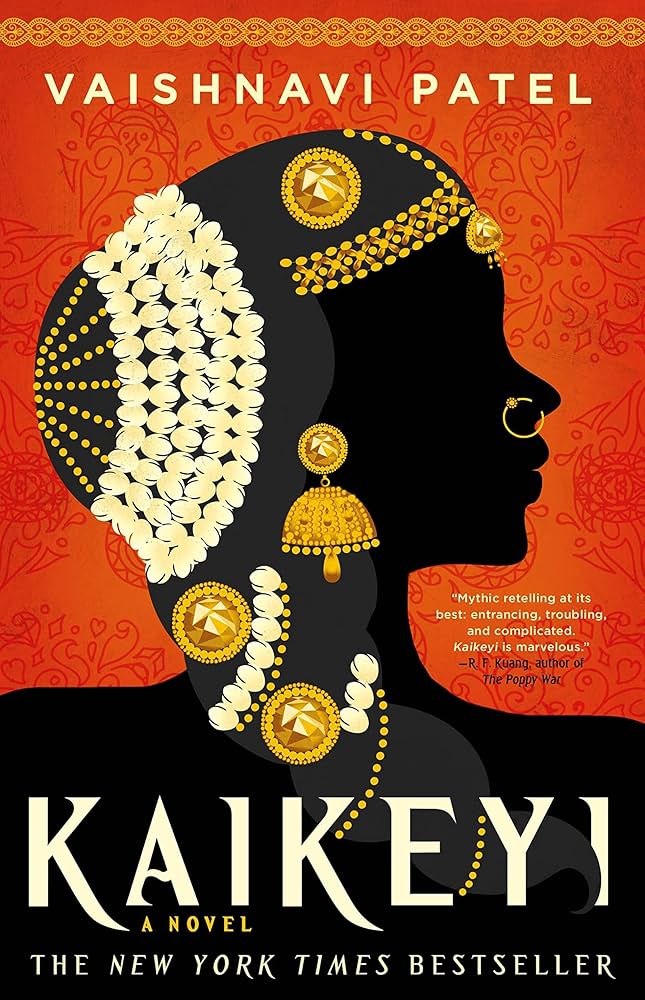Kaikeyi by Vaishnavi Patel follows the titular character, Kaikeyi, a figure from the Hindu epic the Ramayana, which I’m admittedly much less familiar with than Greek mythology. Unlike Circe, I was drawn to this book (and impulse bought it at a Goodwill bookstore) less out of familiarity with the original story and more out of my interest in stories of mythology. The rave reviews of some of my favorite authors listed on the back was an added bonus.
This reimagining is in a similar vein as Madeline Miller’s The Song of Achilles, which tells the story of the Iliad story through the perspective of a lesser character, Patroclus. The Ramayana, the epic that inspired Kaikeyi, was originally composed by the poet Valkimi in Sanskrit some time around 300 B.C.E.. The Ramayana follows the demon-slaying heroics of Rama, an incarnation of Vishnu, the god of preservation. His story begins when he is exiled for 14 years by his father, King Dasharatha, at Kaikeyi’s request. Kaikeyi is portrayed as jealous of Rama, the rightful heir, and wanting her own son Bharatha on the throne, using two boons–essentially unrestricted requests granted by her husband after she saved his life early in their marriage–to crown her son and exile Rama. However, Rama’s adventures make up the bulk of the epic, leaving Kaikeyi on the sidelines.
Patel’s novel turns this approach on its head. Instead of following Rama, Patel relates the series of events that led to the decision that made Kaikeyi one of the most vilified female characters in Hindu mythology. As Kaikeyi herself says in the novel, “Before this story was Rama’s it was mine.” This is where Patel makes space for her twist on the “evil stepmother” story, imagining The novel begins with Kaikeyi’s fraught early life in the kingdom of Kekaya, the only daughter in her family with a cruel father, a distant mother, and many brothers. Soon after her mother’s mysterious departure, which leaves Kaikeyi acting as a surrogate mother for her younger brothers, she develops the ability to see and manipulate relationships in the form of threads–reminiscent of sewing thread and with thickness relative to the strength of the bond. Patel uses this early twist on Kaikeyi’s character as the basis for much of the novel, with Kaikeyi’s supernatural understanding of human connections allowing her to thrive in her husband’s kingdom, while along the way forming strong bonds with her fellow wives and using her influence to advance the lives and rights of other women. Patel emphasizes Kaikeyi’s immense love for her fellow wives’ sons as well as her own biological son, and we come to understand her request of Rama’s exile in a new context of concern and care.
While it contains the characters and basic plot of the Ramayana, many details in Kaikeyi come from more obscure works than the traditional story. While explaining the Ramayana as her inspiration for the novel, Patel tells OrbitBooks, “[W]hile you’ll meet all the characters mentioned here and more, don’t expect a tale that follows the story of the epic. After all, this novel isn’t about the legendary prince…it’s about the evil stepmother.”
Though it was Kaikeyi’s exile that allowed Rama to come into his own, Kaikeyi is a very hated character. Patel’s reimagining of the story gives Kaikeyi a voice to explain her reasoning beyond jealousy and evil step-motherhood. It even presents Kaikeyi as aware of her condemnations, an intriguing fourth-wall break that forces readers to grapple with the question of how women, whether historical or mythological, are remembered–the main interest of this series. Kaikeyi is primarily a story of love, loyalty, and difficult choices, themes that are summed up well in this quote: “Because those who are good question themselves. Because those who are good always wonder if there was a better way, a way that could have helped more and hurt less. That feeling is why you are good.”

